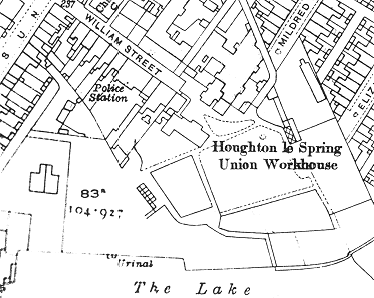Houghton-le-Spring, Durham
Up to 1834
A parliamentary report of 1777 recorded a workhouse in operation at Houghton-le-Spring for up to 16 inmates.
In 1824, a township workhouse for around 200 inmates was erected at the east side of Sunderland Street in Houghton-le-Spring. Its governor in 1827 was John Snaith.
After 1834
Houghton-le-Spring Poor Law Union formally came into existence on 20th January 1837. Its operation was overseen by an elected Board of Guardians, 32 in number, representing its 16 constituent parishes as listed below (figures in brackets indicate numbers of Guardians if more than one):
Parish of Houghton-le-Spring:
Great Eppleton, Little Eppleton, East Herrington, West Herrington, Hetton-le-Hole (6), Houghton-le-Spring (4), Moorhouse, Moorsley (3), Morton Grange, Newbottle (3), Offerton, Painshaw [Penshaw] (3), East Rainton (2), West Rainton (2), Warden Law.
Parish of Bishopwearmouth:
Silksworth.
The population falling within the Union at the 1831 census had been 21,093 — with parishes ranging in size from Little Eppleton (population 17) to Hetton-le-Hole (5,887) and Houghton-le-Spring itself (3,917). The average annual poor-rate expenditure for the period 1833-35 had been £4,606 or 4s.4d. per head of the population.
Initially, the new Houghton-le-Spring Union took over and adapted the existing Sunderland Street workhouse.
A new union workhouse was built in 1864 at William Street in Houghton-le-Spring. It was designed by Matthew Thompson who was also the architect of workhouses for the Chester-le-Street, Hartlepool, and Weardale Unions. His design for Houghton-le-Spring had a corridor-plan T-shaped main block with male accommodation to the west and female to the east. Rooms for the aged were placed at the front of the building, and for children and able-bodied at the rear. The Master's quarters were at the far western end of the building adjacent to the workhouse's main entrance which was located, somewhat unusually, at the rear. The kitchen and dining hall were in the rear wing of the main block. A new board-room and offices were erected in 1891, with the old board-room being converted into lunatic wards including a padded room. The site layout is shown on the 1913 map below.

Houghton-le-Spring workhouse site, 1913
After 1930, the workhouse became a Public Assistance Institution, later known as Heath House Hostel and then just Heath House.
The former workhouse buildings no longer exist.
Cottage Homes
In around 1910, the Houghton-le-Spring Union erected a pair of cottage homes on a small site just to the west of the workhouse (see left of map above).
Staff
Inmates
Records
Note: many repositories impose a closure period of up to 100 years for records identifying individuals. Before travelling a long distance, always check that the records you want to consult will be available.
- Durham County Record Office, County Hall, Durham DH1 5UL. Relatively few records survive — holdings include: Guardians' minutes (1837-1930); Relief lists (1903-30, with gaps); etc.
Bibliography
- Higginbotham, Peter The Workhouse Encyclopedia (2014, The History Press)
Links
- None.
Unless otherwise indicated, this page () is copyright Peter Higginbotham. Contents may not be reproduced without permission.


